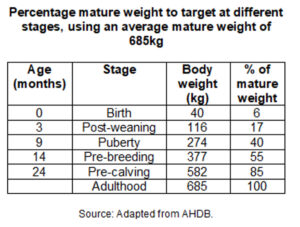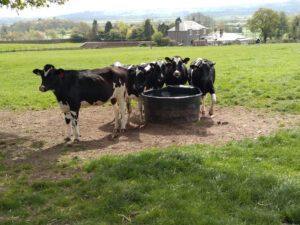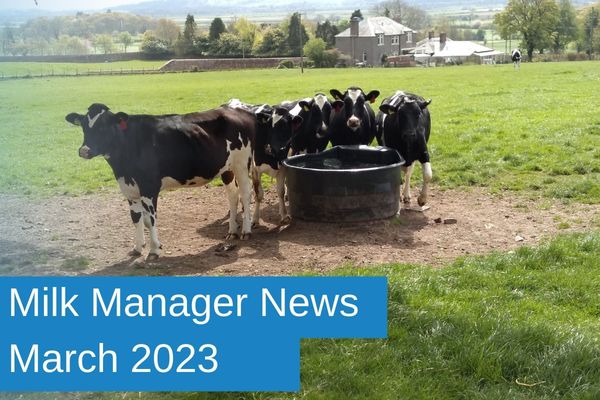Milk Manager News March 2023 – Are Your Heifers Ready For Spring Turnout?
10 March 2023As the days lengthen, thoughts begin to turn to spring turnout and getting heifers ready for the transition from a forage-based diet to a grass-based diet. For the youngest heifers, the change in diet and management will probably be the most sudden they will experience in their lifetime. Heifer growth can be impacted by the change; however it is key to avoid this check in growth when targeting 85% of mature weight for age at first calving being 24 months, as seen in the following table.
Forages like haylage, silage or straw generally have a high dry matter whereas spring grass will have a lower dry matter, resulting in the heifers needing to eat a higher quantity of grass to meet their dry matter intake requirement for good growth. Poor intakes and poor grass quality can impact the heifer’s growth rate during the grazing period. The target dry matter intake for heifers is 2.5% of their bodyweight, and as heifers are still growing, their intake of grass will gradually increase to meet their maintenance requirements. Maintaining a target growth rate of 0.8kg per day can be challenging if grass growth is poor, therefore heifers may not be able to meet their required dry matter intakes.
Calves tend to be selective grazers; therefore it is important to offer fresh grass on a regular basis. Using a rotational grazing system between the calves and yearling heifers, with the yearlings following the calves, will aid grass growth rates and grass utilisation, as the yearling heifers will be more likely to graze down to the target residual of 1500kg DM/ha. Rotationally grazing calves and yearling heifers will create quality leafy grass aiding rumen development. It is important to remember that the rumen bacteria take up to three weeks to adapt to the change in diet and produce the required energy for growth.
Ideally, and if practicable for the system, calves should be grouped at turnout dependant on age and weight. Calves should be monitored regularly, with calves that are not keeping up moved to a more appropriate group. During the transition period, particularly in the youngest heifers, continuing to feed concentrates in the first couple of weeks out at grass will aid in maintaining growth rates. Throughout the summer months, a worming programme should be followed after consultation with your vet.
Ensuring that there is fresh, clean water at grazing is important to help maintain growth rates. If the heifers are grazing similar fields to the milking cows, you may need to consider whether the youngest heifers can reach the trough and utilise it. If grass quality declines, or if the weather is unfavourable, it is important to monitor performance and provide extra feed such as concentrates or forage to prevent any drop in growth rates.
Like milking cows, calves and heifers can become heat stressed if temperatures are above 25°C. To counteract the heat, you may notice calves start to breath quicker, graze less, drink more water, spend less time lying down and spend more time standing up. The heifer’s energy will be diverted to trying to keep coo,l so there will be less energy available for growth. During hot weather, it is important that the calves and heifers have access to areas of shade so that they can move out of direct sunlight.
Getting all the parts of heifer grazing correct can be a challenge, however through careful monitoring and management it can lead to a successful period with heifers reaching their target growth rates of 0.8kg per day.
cara.campbell@sac.co.uk; 01586 552502
Sign up to the FAS newsletter
Receive updates on news, events and publications from Scotland’s Farm Advisory Service



